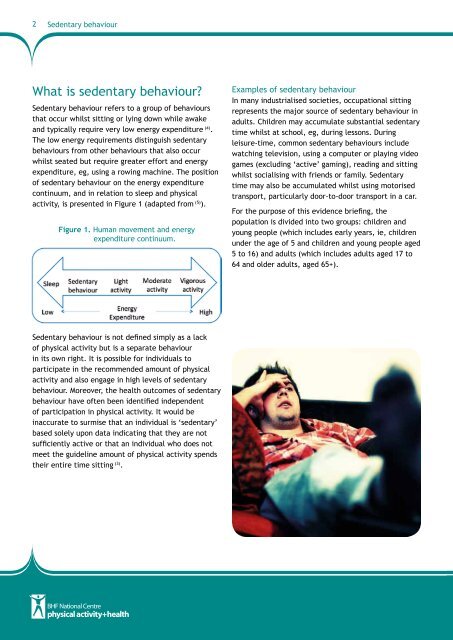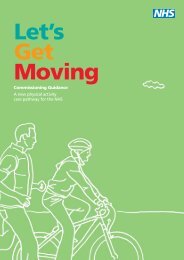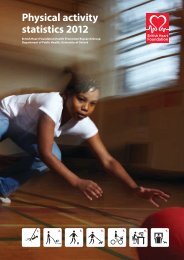Sedentary behaviour evidence briefing - BHF National Centre ...
Sedentary behaviour evidence briefing - BHF National Centre ...
Sedentary behaviour evidence briefing - BHF National Centre ...
You also want an ePaper? Increase the reach of your titles
YUMPU automatically turns print PDFs into web optimized ePapers that Google loves.
2<br />
<strong>Sedentary</strong> <strong>behaviour</strong><br />
What is sedentary <strong>behaviour</strong>?<br />
<strong>Sedentary</strong> <strong>behaviour</strong> refers to a group of <strong>behaviour</strong>s<br />
that occur whilst sitting or lying down while awake<br />
and typically require very low energy expenditure (4) .<br />
The low energy requirements distinguish sedentary<br />
<strong>behaviour</strong>s from other <strong>behaviour</strong>s that also occur<br />
whilst seated but require greater effort and energy<br />
expenditure, eg, using a rowing machine. The position<br />
of sedentary <strong>behaviour</strong> on the energy expenditure<br />
continuum, and in relation to sleep and physical<br />
activity, is presented in Figure 1 (adapted from (5) ).<br />
Figure 1. Human movement and energy<br />
expenditure continuum.<br />
Examples of sedentary <strong>behaviour</strong><br />
In many industrialised societies, occupational sitting<br />
represents the major source of sedentary <strong>behaviour</strong> in<br />
adults. Children may accumulate substantial sedentary<br />
time whilst at school, eg, during lessons. During<br />
leisure-time, common sedentary <strong>behaviour</strong>s include<br />
watching television, using a computer or playing video<br />
games (excluding ‘active’ gaming), reading and sitting<br />
whilst socialising with friends or family. <strong>Sedentary</strong><br />
time may also be accumulated whilst using motorised<br />
transport, particularly door-to-door transport in a car.<br />
For the purpose of this <strong>evidence</strong> <strong>briefing</strong>, the<br />
population is divided into two groups: children and<br />
young people (which includes early years, ie, children<br />
under the age of 5 and children and young people aged<br />
5 to 16) and adults (which includes adults aged 17 to<br />
64 and older adults, aged 65+).<br />
<strong>Sedentary</strong> <strong>behaviour</strong> is not defined simply as a lack<br />
of physical activity but is a separate <strong>behaviour</strong><br />
in its own right. It is possible for individuals to<br />
participate in the recommended amount of physical<br />
activity and also engage in high levels of sedentary<br />
<strong>behaviour</strong>. Moreover, the health outcomes of sedentary<br />
<strong>behaviour</strong> have often been identified independent<br />
of participation in physical activity. It would be<br />
inaccurate to surmise that an individual is ‘sedentary’<br />
based solely upon data indicating that they are not<br />
sufficiently active or that an individual who does not<br />
meet the guideline amount of physical activity spends<br />
their entire time sitting (3) .

















